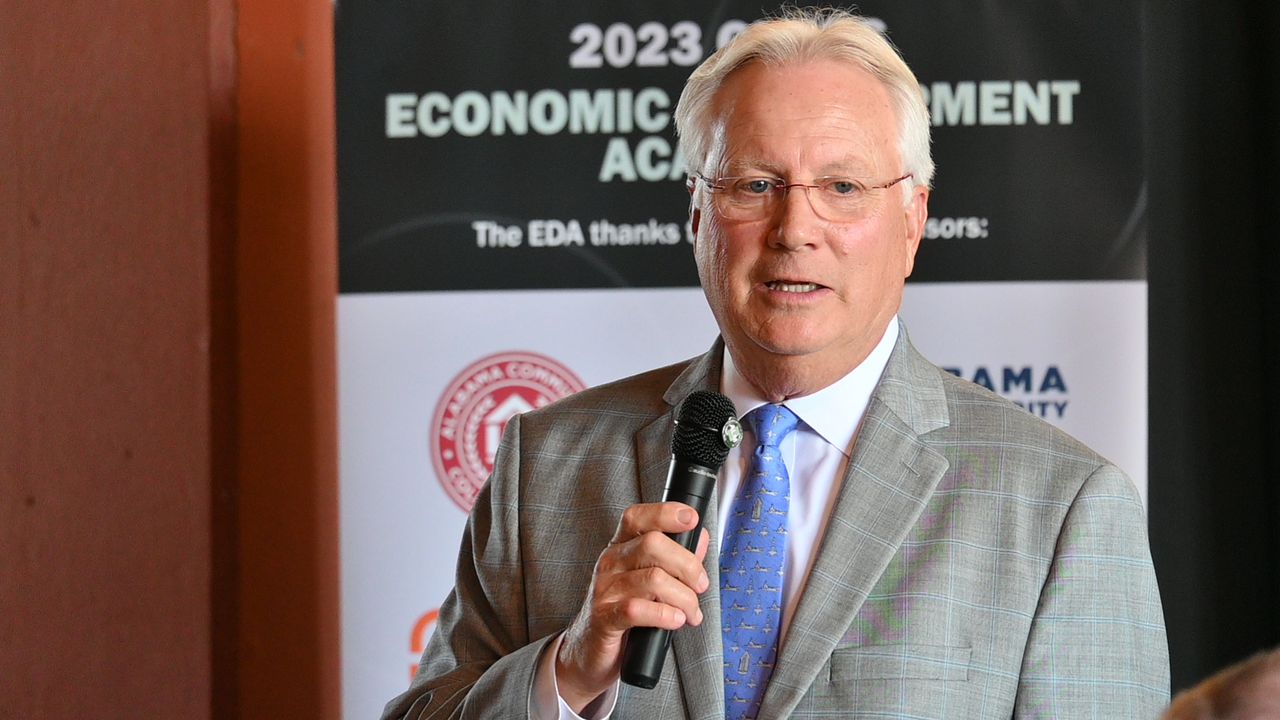How redistricting recreated a radical rightward shift for a South Alabama congressional district
It’s been almost 10 years since a special election runoff for Alabama’s 1st congressional seat was labeled a “political bellwether” for the insurgent tea party movement’s influence among Republicans.
Bradley Byrne, favored among establishment Republicans, defeated tea party darling, Dean Young in a hotly contest Nov. 5, 2013, contest. Byrne’s victory came after he captured much of Mobile’s GOP strongholds, and Baldwin County while Young had a strong showing in mostly rural counties.
Fast forward a decade, and the reliably Republican district in southwestern Alabama no longer has most of those Mobile neighborhoods that Byrne won, due to recent redistricting. And while Baldwin County is the dominant county in the 1st district, it will be joined with seven rural and heavily conservative counties to its east extending into the Wiregrass.
The sudden change of the district is prompting questions:
Would Young have won in 2013?
And could the congressional district, a byproduct of the court-ordered redrawing of the 2nd district to give Black voters a chance to select a candidate of their choice, produce a far-right congressman?
And will future congressmen from this district represent a radical departure from the congressional district’s history of electing more establishment Republicans like Sonny Callahan, Jack Edwards, and Jo Bonner?
“Congressional District 1 is definitely more conservative,” said Jon Gray, a longtime GOP political strategist based in Mobile. “You pick up the Wiregrass, and it’s staunchly conservative. You lose Semmes, Tillman’s Corner. You are not electing a Democrat in CD1.”
He added, “And does Byrne beat Young? No, I think Dean Young wins with that map.”
Rightward shift
How far to the right is the 1st district? Here are some facts:
- Cook Political Report, which recently released a its revised Partisan Voter Index (PVI) after Alabama’s new congressional map was ordered by a federal court on October 5, labeled the 1st district a +28 advantage for Republicans, tied for the sixth most GOP-leaning congressional district in the country. The figure is a remarkable shift from just a few years ago.
- In 2017, Alabama’s 1st district was a +15 advantage for Republicans when Byrne represented the seat. Though a reliably Republican district, it ranked sixth among the state’s six Republican-leaning districts at the time. It was also the 75th most Republican district in the country, meaning its sudden shift further rightward has enabled the district to leapfrog all the GOP strongholds in Texas, Georgia, and beyond.
- The district is now the second most Republican district in Alabama, trailing only Alabama Congressional District 4 represented by U.S. Rep. Robert Aderholt of Haleyville, who is seeking re-election. The 4th district, which includes much of Northwest Alabama and includes rural counties stretching to the Georgia-Alabama state line, is a whopping +33 Republican advantage. That is currently the nation’s No. 1 most Republican district in the U.S. House, according to 2022 PVI ratings.
“In terms of (District 1) being more Republican, it clearly is,” said Byrne, who represented the 1st district from 2014-2021, and is currently the president and CEO of the Mobile Chamber.
Setting the tone
U.S. Rep. Jerry Carl, R-Mobile, speaks during a luncheon hosted by the Alabama League of Municipalities on Wednesday, August 16, 2023, at Ralph & Kacoo’s in Spanish Fort, Ala. (John Sharp/[email protected]).
Incumbent U.S. Rep. Jerry Carl, R-Mobile, is seeking re-election to the district in 2024. Carl, who lives in the district’s most southwestern area of Mobile County is already touting his conservative bona fides in recent days after filing for re-election on Monday.
In his re-election announcement, Carl blasted President Joe Biden, warned of rising crime in American cities and said the country “needs more staunch conservatives like me who will deliver results and never back down from the fight.”
Dothan, with a population of 71,154 residents, is now the largest city in a district that previously included all of the city of Mobile, which is over 200,000 residents.
Carl’s team also released a list of endorsements from mostly public officials in Mobile and Baldwin counties who have already endorsed the congressman’s re-election. Included within the list is Mobile Mayor Sandy Stimpson, whose city is mostly now included in the more left-leaning Alabama Congressional District 2.
“Our local economy is booming, and we are experiencing unprecedented job growth,” Stimpson said. “I’m with Jerry because he is an important part of the team, and we need him to keep fighting for us in Washington.
Carl, a former Mobile County commissioner and longtime businessman in Mobile County, said he’s getting out into the Wiregrass and within areas where constituents are likely unfamiliar with him.
Waiting on Moore

U.S. Rep. Barry Moore, R-Ala., is seen in the U.S. Capitol on Thursday, April 20, 2023. (Tom Williams/CQ Roll Call via AP Images)
Looming is a decision from incumbent U.S. Rep. Barry Moore of Enterprise, whose home has now been drawn into the 1st Congressional District.
The state’s congressional map was redrawn by Special Master Richard Allen, who was appointed by the federal court to propose a map after finding the Alabama Legislature’s maps violated the Voting Rights Act of 1965. The new map redrew Moore’s 2nd district to give Black voters an opportunity to elect a candidate of their choice in a decision that had the backing of a majority of the U.S. Supreme Court.
Democratic Rep. Terri Sewell of Birmingham, who serves in Alabama’s 7th Congressional District, is currently the only Black member of the state’s congressional delegation.
While Moore does not live within the 2nd district, he can run for re-election to his seat under federal law, or he could run for the 1st district. The U.S. Constitution says that if someone is an Alabama resident for one day – and meets the Constitution’s age and citizenship requirements – he or she can run for U.S. House or Senate. The law is different for state and local elections.
The filing deadline is Nov. 10. Thus far, only Carl has filed to run in the 1st district. No one in either the Democratic or Republican parties has filed to run for the 2nd district.
“I think Jerry Carl has a good chance to win this again,” said Jackie Gay, chairperson of the Escambia County Republican Party since 2016. “I’m not sure what Barry Moore plans to do. I don’t know if he’ll run for AL1 or AL2. I don’t think anyone does. I’m sure he’s praying about this.”
Indeed, Moore told a radio show host last month that he was praying over the decision. That occurred before the final map was selected by the federal court, and he has yet to make his intentions known on his political future.
Potential contest
If Moore runs for the 1st district, it could produce the most high-profile Republican primary contest for that seat since the Byrne-Young showdown in 2013. It could also be among the most expensive Republican fights for Congress given the multiple media markets within the 1st district – Mobile, Dothan, and into the Florida Panhandle.

A screenshot of a Club for Growth ad ran against Jerry Carl’s campaign for the Alabama 1st congressional district ahead of the July 14, 2020, runoff. Carl won the GOP runoff against Bill Hightower, who was endorsed by Club for Growth Action. (screenshot image via Club for Growth Action).
It could also spark outsider money: The conservative heavyweight, Club for Growth, vehemently opposed Carl’s campaign in 2020, and backed his opponent, Bill Hightower. Carl won despite the Club’s campaigning against Carl. The Club did back Moore in 2020 during his successful contest against Republican Jeff Coleman.
Baldwin County Republican Party Chairman Patrick McWilliams said if there is a primary contest, he wants it to be a “clean race” void of the mudslinging that occurred in 2020 during both the 1st and 2nd district congressional primaries. McWilliams blamed ‘out-of-state” money from political action committees for the hostile campaigning.
“I’ve spoken to Congressman Carl’s campaign, and they understand our feelings on it,” McWilliams said. “I’m a firm believer of (President Ronald) Reagan’s 11th commandment of ‘thou shall not speak ill of anyone in the party.’ Honestly, the citizens don’t want to see that. They won’t like it in 2024. That does not play well with folks down here.”
Firebrand coming?
But will an outsider step in to rattle the race like Young did in 2013?
Quin Hillyer, a conservative writer for The Washington Examiner, who submitted a proposed map for the judges to consider aimed at keeping Mobile together – and who has been critical of the redrawn boundaries of the 1st and 2nd districts – said the redistricting is likely to attract more ideological extreme candidates.
“This story of districting makes it easier for extremists on both sides to win,” said Hillyer, who ran as a Republican for the congressional seat in 2013. “It means even more now that the candidates in each district plays to their activist base.”
Steven Levitsky, a professor of Government at Harvard University who has weighed in on redistricting concerns in national media outlets, advocates that independent agencies – and not legislatures – be required to redraw congressional districts in every state.
“Election districts should ideally be competitive – that’s how democracy is supposed to work,” Levitsky said. “When we carve up districts with outcomes in mind, meaning we more or less know in advance who will win in each district, the competitive dynamic disappears. The result is usually worse government.”
He said the case in Alabama, where the courts required the 2nd district to be redrawn to better allow for a Black candidate to win, is resulting in the 1st district “with a high likelihood of electing a far-right Republican.”
“The U.S. is virtually unique in allowing the manipulation of election districts with partisan ends,” Levitsky said, adding that it’s a “standard practice in democracies all over the world to have independent agencies or commissions” charged with redistricting, and without partisan election results in mind.
“Court interventions often don’t resolve the underlying problem,” he said.
Byrne said he does not believe the 1st district contests will be ideological battles so much as they will spark regional contests. He said the geographic spread of the district, and its logistical headaches for whomever is elected, will loom large as “a voter won’t see a congressman as much as they used to.”
The traveling distance from Mobile to Dothan is a more than three-hour drive that involves a drive along Interstate 10 through the Florida Panhandle.
“The bigger challenge here is how do you stay in touch with that many people spread over that (range),” Byrne said. “I’ve been complaining about what this does to Mobile, but I can imagine what the people in Dothan thinks. It does hurt them.”
He added, “I don’t have any doubt a congressman in this part of the district will do a lot to help the interests in Dothan and Enterprise. But when you spread yourself out over a large area, and you don’t get any more staff, there will be a give and take here.”
